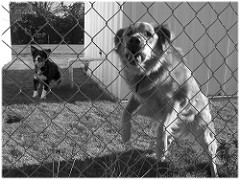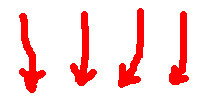When you're going through your German shepherd dog training, keep in mind that the most important thing is to build your relationship. It's important during and after German shepherd dog training that they get plenty of exercise to release their unruly personalities. Before you go in for German Shepherd dog training, you should try to make out a list of the things you are going to teach him and note down what action you will perform from your end. The toughest part of German Shepherd dog training is making them understand the association.
Puppies will begin to show some awareness of "their" people and "their" space at about five or six months of age and will display a desire to warn of approaching strangers.
Obedience training usually refers to the training of a dog and the term is most commonly used in that context. Obedience training ranges from very basic training, such as teaching the dog to reliably respond to basic commands such as "sit", "down", "come", and "stay", to high level competition within clubs such as the American Kennel Club and the Canadian Kennel Club, where additional commands, accuracy and performance are scored and judged.
Obedience implies compliance with the direction or command given by the handler. For a dog to be considered obedient rather than simply trained in obedience, it must respond reliably each time the command is given, by what is commonly known as its handler. A dog can go through Obedience training and not be obedient. If a dog is referred to as being Obedience Trained it should comply immediately with every command its handler gives.
Flat collars are commonly used in clicker training and other non-correction-based training methods. Historically, slip collars have been used as a matter of course, and some trainers still recommend them for basic training on any dog. Martingale collars (also called limited-slip collars) are usually made of flat nylon with a smaller fixed-length section (made of either nylon or a short length of chain) that, when pulled on by the leash, shortens up tightening the collar around the dogs neck. Prong collars (also called pinch collars) are made of metal links which have prongs on the inside of the collar.
Anyone planning to acquire a personal protection dog should choose the dog and the trainer carefully, for a poor dog or a poor trainers can court disaster.

 Stop Dog Barking: The Real Approach To Train Your New Family Dog.
Part of training your dog to stop dog barking is learning t
Stop Dog Barking: The Real Approach To Train Your New Family Dog.
Part of training your dog to stop dog barking is learning t
 Fun at the Park for You and Your Dog
Fun at the Park for You and Your Dog
Fun at the Park for You and Your Dog
Fun at the Park for You and Your Dog
 Stop Dog Digging: Find Fun And Easy Ways To Train Your Dog
A lot of people are trying to maintain a clean home these
Stop Dog Digging: Find Fun And Easy Ways To Train Your Dog
A lot of people are trying to maintain a clean home these
 Playing Tug of War with Your Dog
Playing Tug of War with Your Dog
Playing Tug of War with Your Dog
Playing Tug of War with Your Dog
 Teaching Your Dog Polite Leash Skills - Canine Manners 101 Dog Training Series
Teaching Your Dog Polite Leash Skills
This article i
Teaching Your Dog Polite Leash Skills - Canine Manners 101 Dog Training Series
Teaching Your Dog Polite Leash Skills
This article i